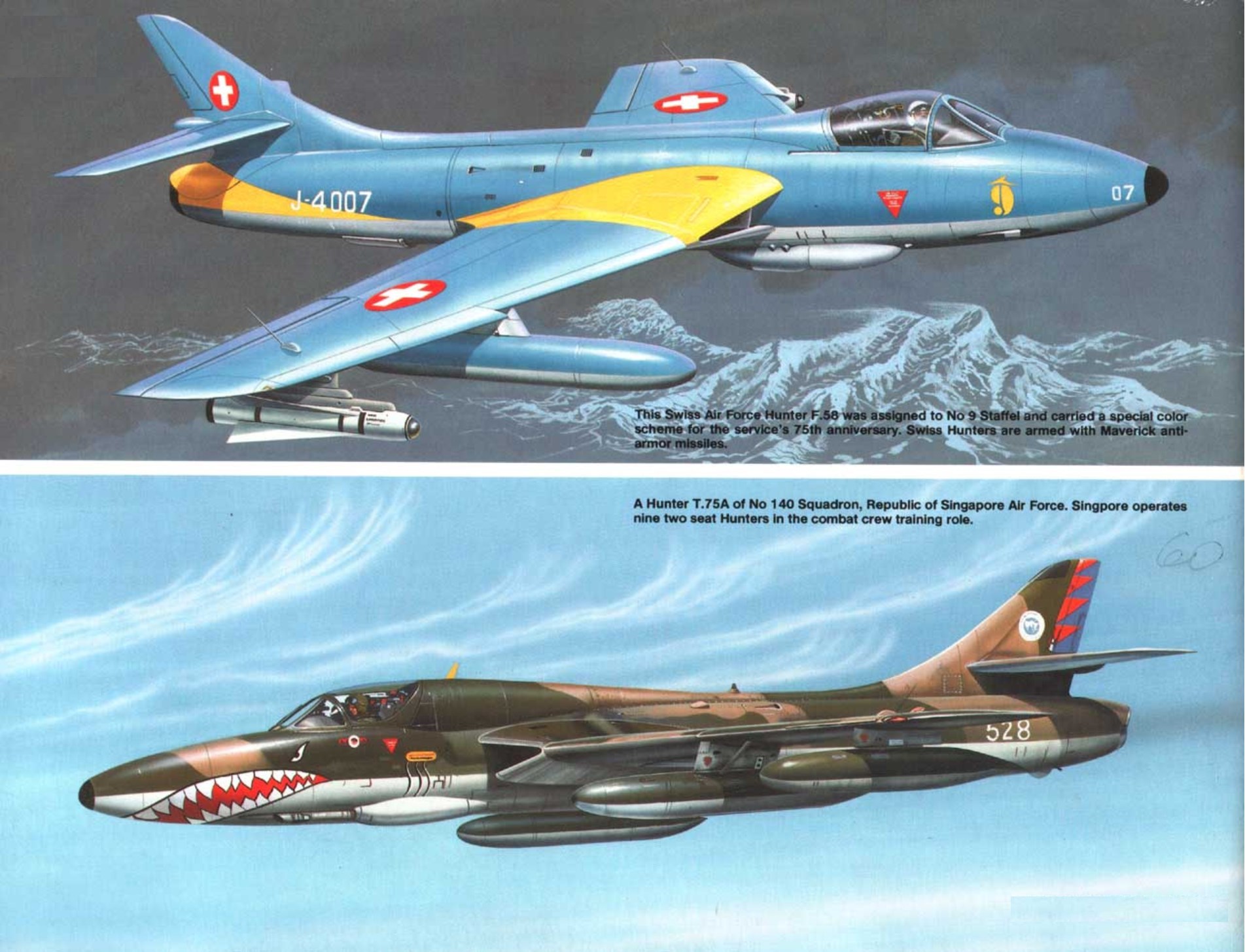
The Hawker Hunter is a transonic single seat fighter / ground attack
monoplane, with swept-back wings, variable incidence tail plane, powered flying
controls and cabin pressurisation. It is powered by a fifteen stage axial flow
Rolls-Royce Avon MK 207 turbine engine developing 10,150 lbs thrust. The
fuselage is of monocoque construction and manufactured in three main sections.
The swept-back wings are two spar stressed skin structures covered with heavy
gauge skin thereby ensuring a perfectly smooth finish and providing for the
necessary stiffness of the internal structure.
Originally designed as an air superiority fighter in the
1950’s, the Hunter went on to become the most successful post-war British
Military aircraft with almost 2000 being produced. Of these, about one third
were later rebuilt by the manufacturer to zero time standard, the last leaving
the Dunsfold factory in 1976. Aided by its high power to weight ratio, inherent
strength and adaptability, the design evolved from the pure fighter in to a
superlative ground attack aircraft, the pinnacle of the design being the Swiss
MK58 Hunters. This version was continuously updated to accommodate the latest
weapons systems prior to being prematurely retired in the mid 1990’s as a
direct result of the end of the Cold War.
In 1944, Sir Sydney Camm, Chief Designer at Hawker Siddeley,
showed the Royal Air Force the design for the P.1040, a fast interceptor
fighter. Little interest was shown in it at first, but a year later the Royal
Navy chose the aircraft as a carrier-capable fighter designated Sea Hawk.
Almost at the same time, Hawker modified the design from P.1040 to the
swept-wing P.1052, which flew for the first time in November 1948. The new
P.1081 design was based on it. Resulting from the experienced gained and the flying
qualities of the P.1052 and P.1081, Hawker Siddeley developed the P.1067 as an
interceptor fighter to combat Soviet bomber formations. The main- and tail
wings had a sweep of 40º and at first sight the aircraft looked like a
radically altered version of the Sea Hawk. The shooting armament was a 30-mm
Aden cannon on floor-mount. The P.1067 took off on 20 July 1951 for the maiden
flight piloted by Neville Duke, and on 7 September 1953 the same test pilot
flew a P.1067 modified into the Hunter F.3 at 1171 km/hr over a measured
3-kilometre stretch for the absolute speed record. Amongst other achievements
the Hunter went through the sound barrier in a dive on several occasions
including at air shows.
The RAF ordered two different versions. The F.1 with an Avon
203 engine (3300 kg thrust) accepted into 43 Squadron in July 1954 and the F.2
fitted with the Armstrong-Siddeley Sapphiere (3,500 kg thrust) which joined 257
Squadron in September the same year. Neither remained in service for long, for
very soon after acceptance the first weaknesses were seen, for example the F.1
engine compressor tended to stall at high altitude when the cannonn was fired.
Fuel consumption of both versions was extremely high and the 1502-litre tank
capacity inadequate, which naturally limited the flight endurance. These
problems were not cured until the introduction of the F.4 when the wing form
was modified and external disposable fuel tanks fitted. The tank capacity was
now between 1,884 litres with a further 910 litres in two additional tanks.The
shape of the Hunter was aerodynamically favourable so that the aircraft soon
became one of the most interesting fighters of its time. The main series model
for the RAF was the F.6 with Rolls-Royce Avon 203 engines produced as from
1955. By 1958 all operational squadrons of the Royal Air Force had been
converted to this type. Later the F.6 received the improved Avon 207 engine.
The Hunter was one of the great British postwar export
successes and was used operationally by over 20 countries: Belgium and the
Netherlands even built it under licence. Numerous acrobatic teams also flew the
Hunter later, amongst others the legendary British “Blue Diamonds” and the
Swiss “Patrouille Suisse”. Even today fifty examples of this elegant machine
can be found in private hands, mainly in Australia, Great Britain and the
United States.
The Hunter was the most successful of the British postwar
fighters, and is remembered as a delightful, capable airplane in every respect.
The prototype was first flown on 20 July 1951, and the single-seat Hunter F1
entered service with the Royal Air Force in July 1954. A two-seat variant, the
Hunter T7, entered service in 1958. Deliveries of the Hunter continued until
1966, and during its life, the airplane was continually modified and improved,
resulting in over 25 variants, including export versions for over 22 foreign
nations. All versions were supersonic, and most variants featured increases in
armament, power and fuel quantity.
Major variants included the F4 (Avon Mk 115 engine,
increased fuel capacity from earlier versions); F5 (Sapphire Mk 101 engine); F6
(Avon Mk 203 engine, increased fuel capacity); T8 (Two-seat Navy version); FR10
(RAF reconnaissance version); GA11 (Royal Navy single-seat attack version; and
FGA9 (Greater weapons capacity, increased thrust, strengthened fuselage for
ground-attack role.)
Until just a few years ago, almost 20% of all Hunters built
were still in service (mainly with the Swiss Air Force, RAF and Royal Navy),
but as of 1998, only Zimbabwe’s Hunters are still in front-line service. At
least 30 are still airworthy in private hands.
Specifications
(Hunter F6):
Engine: One
10,150-pound thrust Rolls-Royce Avon Mk207 turbojet
Weight: Empty
14,120 lbs., Max Takeoff 23,800 lbs.
Wing Span:
33ft. 8in.
Length: 45ft.
10.5in.
Height: 13ft.
2in.
Performance:
Maximum
Speed at Sea Level: 650 mph
Ceiling:
51,500 ft.
Range:
1,400 miles in ferry configuration (Combat radius 230 miles)
Armament:
Four 30mm
Aden cannon
Four
underwing pylons for 500 or 1000-pound bombs, 24 76-mm rockets, or fuel tanks.
Number Built: 1,985